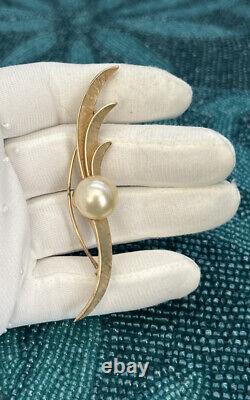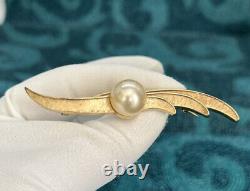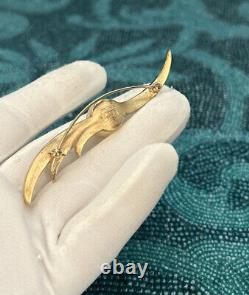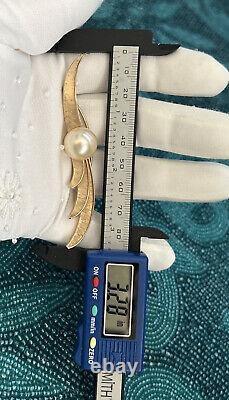VTG CROWN TRIFARI TEXTURED FAUX PEARL RIBBON BROOCHBy Alfred Philippe





VTG CROWN TRIFARI TEXTURED FAUX PEARL RIBBON BROOCH BY ALFRED PHILIPPE HARD TO FIND. THIS BROOCH DESIGN LOOKS LIKE REAL GOLD JEWELRY BROOCH. CONDITION IS VERY GOOD, little bit (2 tiny scratches on the large pearl). Trifari costume jewelry has a long and colorful history.
Gustavo Trifari, the company's founder, came from a family of goldsmiths in Naples, Italy. Trifari came to the United States in the early 20th century and began making his beautiful Trifari jewelry in 1910.
The Founding of the Trifari Brand. Soon after launching the Trifari costume jewelry line, Gustavo Trifari joined forces with his uncle and renamed the business Trifari and Trifari. After the uncle left the company, Trifari kept fabricating his costume jewelry under the Trifari brand. By 1925, Gustavo Trifaro combined his brand with sales managers Leo Krussman and Carl Fishel.The growing company was known as Trifari, Krussman and Fishel. What Made Trifari Stand Out. Creating beautiful Trifari costume jewelry was no small feat, and Trifari was known for its rigorous quality control measures. Many collectors agree that Trifari jewelry pieces, especially those from the 1930's-1960, are far above competitors' offerings. Over the years, Trifari reworked a central group of jewelry designs.
Many distinctive pieces featured colored stones or enameled effects. Other Trifari gold-tone and silver-tone pieces were designed to stand alone. Highly skilled designers frequently used sterling silver, or a gold-plated finish called vermeil, for hand-set jewelry frames. Trifari's designers used these techniques, as well as added embellishments such as imitation moonstone, faux pearls, paste gemstones, and rhinestones.
After World War II, Trifari created its own gold-tone alloy. This non-tarnishing metal was known as Trifanium. This novel metal helped place Trifari jewelry above other jewelry pieces at the time. The driving force behind Trifari jewelry's popularity, and the reason it's collectible today, was lead designer Alfred Philippe. He came to Trifari in 1930 after working for renowned fine jewelry firms Cartier and Van Cleef & Arpels. During Philippe's tenure at these companies, he developed invisible stone settings and brought that high-end technique to Trifari. Philippe familiarized other Trifari designers with fine jewelry design and fabrication methods. The name "Trifari Alfred Philippe" was renowned for almost 40 years. Phillippe served as Trifari's lead designer until 1968. Examples of Alfred Philippe Creations.Alfred Philippe introduced many high-profile jewelry designs. His Crown Trifari brooches reigned from the late 1930s to the 1950s. Crown Trifari brooch pins are enhanced by brilliantly colored cabochons or dazzling clear rhinestones. Crown Trifari jewelry became so popular that Trifari added a crown to its signature mark, sometime around 1937.
Today, vintage Crown Trifari is a sought-after treasure. Custom Designs for 1930s-era Actors. In a shrewd marketing move, Trifari worked with 1930s-era Broadway and Hollywood producers to fabricate custom jewelry pieces for famous actors. Thus, Trifari re-positioned its brand and enhanced its market status.
THE TRIFARI BRAND CHANGES DIRECTION. In 1994, Trifari became part of the Monet Group, another quality vintage costume jewelry brand. In 2000, The Liz Claiborne ladies' clothing brand acquired the Monet Group, placing upscale fashions and quality costume jewelry under one umbrella. Soon afterward, Liz Claiborne moved Trifari jewelry production overseas, likely because of the economic advantages. The newer products don't display a stamp. This development would imply that Trifari jewelry no longer reflects the ultra-high quality standards that became the company's hallmark during the early-to-middle 20th century. How World War II Affected Trifari Production. During World War II, pot metals' availability was limited by rationing.As a result, Trifari substituted sterling silver, which tripled the jewelry prices. After World War II, Trifari sought to return to a less-expensive, no-maintenance metal. However, its customer base was now accustomed to silver. To refocus customers' attention, Trifari began promoting a "new" metal called Trifanium.
This was the same pre-war pot metal that could accept a rhodium finish. The Monet Group, Liz Claiborne, and Mass Production. In 1994, Trifari became part of the Monet Group. The Liz Claiborne brand acquired the Monet Group in 2000, setting the stage for overseas Trifari jewelry production. The new, low-quality products don't display a stamp. SHOPPING FOR TRIFARI JEWELRY: WHAT TO LOOK FOR. As Trifari continued its impressive market growth, other companies copied the jewelry maker's work. To counter this threat, Trifari frequently published fashion magazine ads that stated If it isn't signed, it isn't Trifari. This is something to keep in mind as you shop for authentic Trifari jewelry. Trifari jewelry design markings are good indicators of an authentic piece of Trifari jewelry. And different markings can typically be used to identify a piece's era. However, the company may have used a surplus of stamped clasps or other findings on newer jewelry pieces, so this isn't a foolproof criterion. The three-letter "KTF" mark denoted the Trifari, Krussman and Fishel era. The "KTF" appeared with a larger "T" in the center. This mark is on jewelry pieces made from the mid-1920s until approximately 1930. Mark and the Crown Trifari Mark. Trifari began using the TRIFARI PAT. Mark in the early 1930s. During the late 1930s, Trifari also used the Crown Trifari mark featuring a crown above the letter T. The Crown Trifari mark is on jewelry pieces made from 1937 to 1955.This revised mark appears on jewelry designs made from 1955 to 1969. Trifari's popular fruit and vegetable pins also feature the Crown Trifari mark. During the 1970s, Trifari dropped the crown symbol from its signature mark. During the late 1980s, Trifari stamped a "Trifari TM" mark on its costume jewelry. In 2000, the Liz Claiborne brand took over Trifari's operations.
Trifari jewelry has not displayed marks since that time. Trifari enjoyed a longstanding prominence in the costume jewelry market.
Over the years, the company adopted a number of distinctive styles. The early 1930s Art Deco jewelry designs emphasized geometric shapes. During the later 1930s and 1940s, Trifari's "Diamante" jewelry was in vogue. These stunning pieces were set in metals resembling gold, silver, and platinum. The Diamante stones imitated diamonds and precious gemstones.
Following World War II, Trifari debuted its cocktail-styled jewelry designs. These pieces often featured floral sprays and enameled effects. During the 1960s, Trifari jewelry became more structured and often included pearl effects.
The 1970s became the Trifari enameled era. During the early 1980s, the Kunio Matsumoto design series was extremely popular. The 1990s saw many reissued jewelry designs that gained some notoriety. Over the years, Trifari's designers created a number of figurals, or themed jewelry pieces. The following are some of the most-celebrated Trifari Jewelry pieces.
These popular designs often took the shape of colorful animals. During World War II, Trifari introduced several patriotic pins.
Pieces included inspiring American flags and majestic red, white, and blue eagles. Trifari's 1940s-era Jelly Bellys brooches depicted miniature animals, such as poodles and roosters. The animal's "belly" was a solid Lucite "pearl" in a sterling silver or gold plate setting. The poodle Jelly Bellys are very rare, but any Jelly Belly is worth a pretty penny. The iconic Clip-Mates were both stylish and functional.Created in two pieces, each Clip-Mates set formed a beautiful brooch when displayed together. Separately, each Clip-Mate served as a dress clip. Trifari's 1930s-era floral brooches were wildly popular.
Each brooch featured a striking setting, accented by faux floral sculptures and sprays. Trifari's legendary crown brooches featured individually-set rhinestones and colorful cabochons.
The latter embellishments were less labor-intensive than faceted stones. The Trifari fruit and vegetable pins, popular from the late 1950s through the 1960s, featured colorful fruits and vegetables in matte gold or silver settings. The pieces could be displayed alone or in a group.
WHERE TO FIND VINTAGE TRIFARI JEWELRY. You'll likely discover vintage Trifari jewelry pieces in different venues. Pay close attention to the items' attributes and markings. Antiques and collectibles shops could yield Trifari vintage jewelry finds.
Browse carefully through the tabletop display cases. Some online marketplaces feature hundreds of vintage Trifari jewelry pieces. With a national reach, you may find an especially good selection of stunning Trifari brooches, such as a leaf brooch or rhinestone brooch. Or, maybe a pendant necklace, choker necklace, or earrings set is your style. With multiple listings, it's easier to determine a Trifari necklace value. However, when shopping online, it's hard to determine the authenticity of the piece. It's always best to have the jewelry in hand and look for the authenticity of the markings.Estate sales are excellent sources for vintage costume jewelry. For example, you could discover a matching Trifari necklace, Trifari bracelet, and Trifari earrings. This stunning set perfectly exemplifies a parure or matching jewelry.
This item is in the category "Jewelry & Watches\Vintage & Antique Jewelry\Brooches & Pins". The seller is "anianj" and is located in this country: US.This item can be shipped worldwide.
- Number of Diamonds: 0
- Antique: No
- Occasion: All Occasion
- Main Stone Color: Gold Color
- Metal: Gold Plated
- Secondary Stone: Faux Pearl
- Jewelry Department: Fashion
- Vintage: Yes
- Main Stone: Faux Pearl
- Main Stone Treatment: Simulated
- Department: Women
- Main Stone Shape: Round
- Base Metal: Mixed Metals
- Number of Gemstones: 0
- Main Stone Creation: Simulated
- Crown Trifari 18kgp Faux Pearl Brooch: 18kgp Metal, Faux Pearl
- Signed: Yes
- Color: Gold, White
- Material: Yellow Gold Plated Metal, Faux Pearl, Silver tone
- Modified Item: No
- Brand: Crown Trifari
- Type: Brooch
- Customized: No
- Era: Mid Century
- Theme: Statement
- Original/Reproduction: Original
- Country/Region of Manufacture: United States
- Country of Origin: United States
- Wholesale: No

